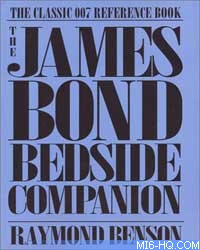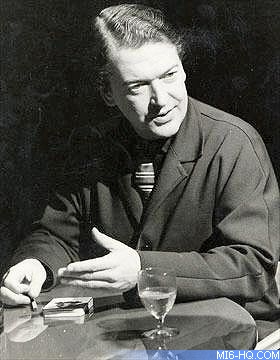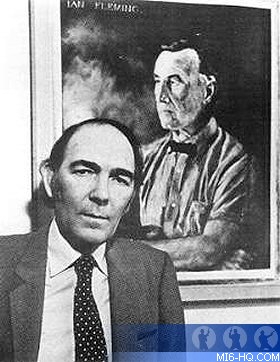 |
| |
MI6 caught up with the fourth official James Bond
author last month and chatted about his life before,
during and after his work with the world's most famous
literary spy...
|
|
Raymond Benson Interview (1)
11th May 2004
In this first of a three part interview with Raymond Benson,
we talk about the lead up to his work on Bond.
What was your first experience with Bond? Was it `love at first
sight`, or did it take time for the passion to develop? Did crossing
over from your initial experience (film to books or books to film)
change how you saw the character?
"M" turned me on to James Bond when I was nine years
old. I kid you not. I was growing up in a small West Texas town
in the early sixties. I was friendly with two girls that were
slightly younger than I was-they lived next door. Their mother
was a woman who went by the name "M." I don't recall
the story behind that, maybe her real name began with an M and
she didn't like the name, so all her friends called her M.
| "Goldfinger
opened up an entirely new fantasy world for me."

Above: Goldfinger, US One Sheet Reprint
 Buy
Now £7.99
Buy
Now £7.99
|
|
Anyway, I was over at their house playing with the girls
one day in late 1964 and I heard this loud, brassy music
coming from the family stereo. I asked, "What's that
music?" The girls' mom, M, showed me the record album-it
was the soundtrack to Goldfinger.
I was immediately fascinated. I loved Shirley Bassey's
gutsy rendition of the title song and the snippets of "The
James Bond Theme." The photos on the LP cover were
cool and sexy. I got M to tell me about this James Bond
character and about the movie, which she and her husband
had seen at one of the only two cinemas in town.
I was intrigued. Then, when the film came back to the drive-in
theater in early 1965, I forced my father to take me to
see it. And yes, it was love at first sight. You have to
remember that the Bond films were the "Star Wars"
of that decade-the blockbuster action films that everyone
wanted to see. Goldfinger opened up an entirely new fantasy
world for me (there was nothing else to occupy my imagination
in West Texas!). M also owned a few of the Ian Fleming paperbacks
and I found myself looking at these. The first one I read
was Dr. No and I was still only nine years old.
|
In the summer of 1965, the double bill re-release of Dr. No and
From Russia With Love came to town. I must have seen that double
bill four or five times in the theater. I kept reading the books,
and then by early 1966 I had seen Thunderball. So within a year's
time I had seen the first four films and read many of the Fleming
books. I was probably too young to completely understand the books
at that time but I certainly got the gist of them. I re-read them
a couple of years later, then again when I was in high school.
And yet again just before writing the Bedside Companion. I suppose
at first I didn't realize the disparity between the literary Bond
and the cinematic Bond (in the early films the difference wasn't
so great). By the time You Only Live Twice was released in 1967,
though, I could see that the films were going in a direction that
the books never did.
|
Your book "The James Bond Bedside Companion"
is considered by many as the best reference work on the
007 canon. Did you think at the time that this work would
lead you to becoming more involved?
Are you kidding? Of course not. The Bedside Companion
was undertaken strictly as a labor of love and as time went
on it became an obsession. During the 1970s I had gone to
high school and college, studied and received a degree in
theatre, and in 1979 I moved to New York City. I was still
a Bond fan during those years but more of a closet fan.
I wasn't particularly keen on the Roger Moore films of the
70s but I still enjoyed them. My friends knew I was a bit
of a Bond fanatic but I hid it well.
In New York I immersed myself in the theatre-mostly as
a stage director, sometimes as a music composer-and did
this intensely for two years. Then, in 1981, two things
happened that re-sparked my interest in Bond. The first
was John Gardner's Bond debut, License Renewed. The second
was the film For Your Eyes Only.
|
|
"The
book established me as something of a Bond authority..."

Above: The James Bond Bedside Companion.
|
I enjoyed Gardner's book-it was refreshing to have a new Bond
novel after so many years. And I thought "For Your Eyes Only"
was the best Roger Moore Bond film (and I still think that). It
had brought the films back to Fleming. Then, in October of '81
or so, my friends and I were sitting around talking and the question
came up-"What book would you write if you had to write one?"
We went around the table and I answered, "I think I'd write
a reference book about James Bond." My friends all went,
"Ooooh, you should do that! You know a lot about Bond!"
The more I thought about it, the more it sounded like a fun project
to do in my spare time.
| "
I met many of Fleming's friends and colleagues, such as
Ivar Bryce, Robert Harling, and Clare Blanshard. I met and
interviewed Kingsley Amis and John Pearson. "

Above: Kingsley Amis
|
|
I was a bit frustrated with the theatre because there's
no money in that. I was working a nine-to-five job for money.
So I talked to a friend that had written and published a
joke book. He gave me the contact number for his editor
and I wrote her a letter, explaining what I wanted to do.
She told me to write an outline of the book and the first
couple of chapters. I did this and gave this proposal to
her by December of '81.
Much to my surprise, I got a contract and an advance to
write the book. It took three years from conception to publication.
In the summer of 1982 I traveled to England and met members
of Ian Fleming's family, both on his side and on Ann Fleming's
side.
I met Peter Janson-Smith, who was Fleming's literary agent
and the main man at Glidrose Publications, the literary
copyright holders. (The company is now called Ian Fleming
Publications Ltd.) I met many of Fleming's friends and colleagues,
such as Ivar Bryce, Robert Harling, and Clare Blanshard.
I met and interviewed Kingsley Amis and John Pearson.
|
Back in the States I spent time at the Lilly Library at Indiana
University, studying Fleming's original typescripts. I met and
interviewed people associated with Fleming in America, such as
Ernest Cuneo, Jo Bryce, and his American agent and editor. At
one point I met and interviewed Kevin McClory. (No one at EON
would have anything to do with me!) Anyway, the book was published
in November 1984. The people at Glidrose liked it a lot, as did
the Fleming's, and we kept in touch.
|
The book established me as something of a Bond authority
so I got more involved with fan clubs, conventions, and
other Bond-related activities. I became Vice President of
the American fan club and contributed to its magazine "Bondage."
I also contributed to the British fan club's magazine,
"007." I did little odd jobs for Glidrose at times,
the main one being the writing of the stage play of Casino
Royale in 1986. So I was always close to the people at Glidrose
for the next 15 years, but did I ever think in my wildest
dreams that I would one day be writing the Bond novels?
No way!
|
|

Above: Raymond Benson
|
How did (then) Glidrose approach you to take over from John
Gardner after he announced his retirement from the series? What
did you have to do to win the job?
Between the Bedside Companion and my first Bond novel, my career
took a number of twists and turns. I still did theatre, I worked
for a famous architect in Manhattan, and I got involved in the
computer game industry. I had always been into games, even back
in the good old pencil and paper Dungeons and Dragons days. I
really enjoyed the James Bond 007 Role-Playing Game when it came
out in 1983. I got to know the creators of that (they were based
in New York) and eventually I found myself writing an adventure
module (You Only Live Twice II-Back of Beyond).
| "Peter
Janson-Smith phoned me in November 1995. He told me that
John Gardner was retiring from the Bond gig."

Above: John Gardner
|
|
Through networking I got a job designing and writing two
Bond "text-adventure" computer games in 1985-A
View to a Kill and Goldfinger, along with a Stephen King
adaptation.
I taught a class on James Bond at the New School for Social
Research in New York as well as other film classes. I interviewed
Timothy Dalton for the New York Daily News during the Licence
to Kill promotion.
In 1990 my family and I moved back to Texas, where I got
a job as a computer game designer/writer. For the early
part of the 90s, I climbed that industry's ladder, working
for no less than four different game companies and moving
my family cross-country three times!
We ended up in the suburbs of Chicago, and that's where
I was when Peter Janson-Smith phoned me in November 1995.
He told me that John Gardner was retiring from the Bond
gig. "Would you like to give it a shot?" he asked.
It came from out of the blue. I never expected it, nor did
I ask for it. With much trepidation, I accepted the challenge.
|
But first I had to pass a couple of tests. Before I got the contract,
I had to write an outline of a story for approval-by Glidrose
and the British publisher, Hodder & Stoughton. On spec. Once
that was done, I had to write the first four chapters on spec.
It was March 1996 when everything was finally set in stone and
I got the contract to write the first book. Now, to dispel some
misconceptions about my qualifications for writing the books,
it wasn't as if Glidrose plucked a non-professional writer from
the ranks of "fans" to write the novels. Yes, I was
a fan. I knew the Bond Universe inside and out. And that was the
first reason they wanted me. But secondly, I was a professional
writer. I had been writing professionally for fifteen years up
to that point. Maybe not novels, but certainly fiction. My theatre
training had taught me how to tell a story, about dramatic structure,
about dialogue. My gaming experience taught me how to create complex
plots. My instincts guided me with regard to what was "Bond"
and what wasn't. I felt I could do it, and I'm eternally grateful
to the 1996 Board of Directors of Glidrose Publications for giving
me the chance.
Believe me, if I had written a load of rubbish, Glidrose wouldn't
have accepted it. Hodder & Stoughton wouldn't have accepted
it. Putnam (in America) wouldn't have accepted it. I was edited
three ways, and these people were no dummies. There was a lot
of quality control. My biggest worry was that I was an American.
Glidrose and my editor at Hodder did a very good job of making
sure Americanisms didn't creep in. I think early on they invariably
did, but I got better and better at writing "British"
as time went on. I'll say right here that I'm no Ian Fleming and
never will be. No one will be. Ever again. And fans shouldn't
expect that. Fleming's writing was very "literary" even
though at the time it was considered pulp fiction. These days,
the publishers want what could be called easy-to-read "commercial
fiction." They want to appeal to a broad base of readers,
young and old. I think if you examine the work of a lot of suspense
writers-people like John Grisham, John Sandford, James Patterson,
Tess Gerritsen, Dan Brown-you'll find that their writing styles
are really not much different from mine. It's commercial fiction,
plain and simple.
Many thanks to Raymond Benson. Images
courtesy Movie Market& Amazon Associates
Keep an eye out for the second part of the interview where we
chat about writing the novels...
Related Articles
 MI6 Literary 007 Coverage
MI6 Literary 007 Coverage
 MI6
Interview - Raymond Benson (Part 2)
MI6
Interview - Raymond Benson (Part 2)
 MI6
Interview - Raymond Benson (Part 3)
MI6
Interview - Raymond Benson (Part 3)
 Raymond
Benson Official Website
Raymond
Benson Official Website